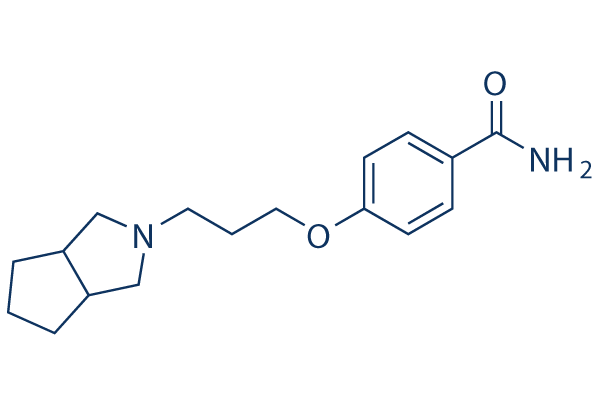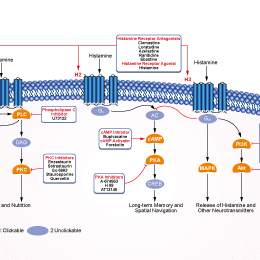
- Bioactive Compounds
- By Signaling Pathways
- PI3K/Akt/mTOR
- Epigenetics
- Methylation
- Immunology & Inflammation
- Protein Tyrosine Kinase
- Angiogenesis
- Apoptosis
- Autophagy
- ER stress & UPR
- JAK/STAT
- MAPK
- Cytoskeletal Signaling
- Cell Cycle
- TGF-beta/Smad
- DNA Damage/DNA Repair
- Compound Libraries
- Popular Compound Libraries
- Customize Library
- Clinical and FDA-approved Related
- Bioactive Compound Libraries
- Inhibitor Related
- Natural Product Related
- Metabolism Related
- Cell Death Related
- By Signaling Pathway
- By Disease
- Anti-infection and Antiviral Related
- Neuronal and Immunology Related
- Fragment and Covalent Related
- FDA-approved Drug Library
- FDA-approved & Passed Phase I Drug Library
- Preclinical/Clinical Compound Library
- Bioactive Compound Library-I
- Bioactive Compound Library-Ⅱ
- Kinase Inhibitor Library
- Express-Pick Library
- Natural Product Library
- Human Endogenous Metabolite Compound Library
- Alkaloid Compound LibraryNew
- Angiogenesis Related compound Library
- Anti-Aging Compound Library
- Anti-alzheimer Disease Compound Library
- Antibiotics compound Library
- Anti-cancer Compound Library
- Anti-cancer Compound Library-Ⅱ
- Anti-cancer Metabolism Compound Library
- Anti-Cardiovascular Disease Compound Library
- Anti-diabetic Compound Library
- Anti-infection Compound Library
- Antioxidant Compound Library
- Anti-parasitic Compound Library
- Antiviral Compound Library
- Apoptosis Compound Library
- Autophagy Compound Library
- Calcium Channel Blocker LibraryNew
- Cambridge Cancer Compound Library
- Carbohydrate Metabolism Compound LibraryNew
- Cell Cycle compound library
- CNS-Penetrant Compound Library
- Covalent Inhibitor Library
- Cytokine Inhibitor LibraryNew
- Cytoskeletal Signaling Pathway Compound Library
- DNA Damage/DNA Repair compound Library
- Drug-like Compound Library
- Endoplasmic Reticulum Stress Compound Library
- Epigenetics Compound Library
- Exosome Secretion Related Compound LibraryNew
- FDA-approved Anticancer Drug LibraryNew
- Ferroptosis Compound Library
- Flavonoid Compound Library
- Fragment Library
- Glutamine Metabolism Compound Library
- Glycolysis Compound Library
- GPCR Compound Library
- Gut Microbial Metabolite Library
- HIF-1 Signaling Pathway Compound Library
- Highly Selective Inhibitor Library
- Histone modification compound library
- HTS Library for Drug Discovery
- Human Hormone Related Compound LibraryNew
- Human Transcription Factor Compound LibraryNew
- Immunology/Inflammation Compound Library
- Inhibitor Library
- Ion Channel Ligand Library
- JAK/STAT compound library
- Lipid Metabolism Compound LibraryNew
- Macrocyclic Compound Library
- MAPK Inhibitor Library
- Medicine Food Homology Compound Library
- Metabolism Compound Library
- Methylation Compound Library
- Mouse Metabolite Compound LibraryNew
- Natural Organic Compound Library
- Neuronal Signaling Compound Library
- NF-κB Signaling Compound Library
- Nucleoside Analogue Library
- Obesity Compound Library
- Oxidative Stress Compound LibraryNew
- Plant Extract Library
- Phenotypic Screening Library
- PI3K/Akt Inhibitor Library
- Protease Inhibitor Library
- Protein-protein Interaction Inhibitor Library
- Pyroptosis Compound Library
- Small Molecule Immuno-Oncology Compound Library
- Mitochondria-Targeted Compound LibraryNew
- Stem Cell Differentiation Compound LibraryNew
- Stem Cell Signaling Compound Library
- Natural Phenol Compound LibraryNew
- Natural Terpenoid Compound LibraryNew
- TGF-beta/Smad compound library
- Traditional Chinese Medicine Library
- Tyrosine Kinase Inhibitor Library
- Ubiquitination Compound Library
-
Cherry Picking
You can personalize your library with chemicals from within Selleck's inventory. Build the right library for your research endeavors by choosing from compounds in all of our available libraries.
Please contact us at info@selleckchem.com to customize your library.
You could select:
- Antibodies
- Bioreagents
- qPCR
- 2x SYBR Green qPCR Master Mix
- 2x SYBR Green qPCR Master Mix(Low ROX)
- 2x SYBR Green qPCR Master Mix(High ROX)
- Protein Assay
- Protein A/G Magnetic Beads for IP
- Anti-Flag magnetic beads
- Anti-Flag Affinity Gel
- Anti-Myc magnetic beads
- Anti-HA magnetic beads
- Magnetic Separator
- Poly DYKDDDDK Tag Peptide lyophilized powder
- Protease Inhibitor Cocktail
- Protease Inhibitor Cocktail (EDTA-Free, 100X in DMSO)
- Phosphatase Inhibitor Cocktail (2 Tubes, 100X)
- Cell Biology
- Cell Counting Kit-8 (CCK-8)
- Animal Experiment
- Mouse Direct PCR Kit (For Genotyping)
- New Products
- Contact Us
S 38093
S 38093 is a histamine H3 antagonist/inverse agonist with a moderate affinity for rat, mouse and human H3 receptors (Ki = 8.8, 1.44 and 1.2 μM, respectively) and no affinity for other histaminergic receptors.

S 38093 Chemical Structure
CAS No. 862896-30-8
Purity & Quality Control
Batch:
S859801
DMSO]57 mg/mL]false]Ethanol]57 mg/mL]false]Water]Insoluble]false
Purity:
99.85%
99.85
S 38093 Related Products
| Related Targets | H1 receptor H2 receptor H3 receptor H4 receptor | Click to Expand |
|---|---|---|
| Related Products | GSK2879552 2HCl JNJ-7777120 Mianserin HCl Ebastine Ciproxifan Maleate | Click to Expand |
| Related Compound Libraries | FDA-approved Drug Library Natural Product Library Neuronal Signaling Compound Library CNS-Penetrant Compound Library Anti-alzheimer Disease Compound Library | Click to Expand |
Signaling Pathway
Biological Activity
| Description | S 38093 is a histamine H3 antagonist/inverse agonist with a moderate affinity for rat, mouse and human H3 receptors (Ki = 8.8, 1.44 and 1.2 μM, respectively) and no affinity for other histaminergic receptors. | ||||||
|---|---|---|---|---|---|---|---|
| Targets |
|
| In vitro | ||||
| In vitro | In cellular models, the compound was able to antagonize mice H3 receptors (KB = 0.65 μM) and to suppress cAMP decrease induced by an H3 agonist via human H3 receptors (KB = 0.11 μM). Among the four histaminergic receptor subtypes, S 38093 is selective for the H3 receptor, its binding affinity for H1, H2 and H4 receptors being negligible[1]. | |||
|---|---|---|---|---|
| Cell Research | Cell lines | HEK-293 cells | ||
| Concentrations | 0.01-100 μM | |||
| Incubation Time | 1 h | |||
| Method | The cells (2 x 106 per ml) were harvested and suspended in Hank's balanced salt solutions/HEPES (pH7.4) buffer containing 1 mM isobutyl-methylxanthine and 1mg/ml of BSA. The fluor 647-anti cAMP antibody solution (1 μl) was added to the cell suspension (100 μl) and 6 μl aliquots of this mix were dispensed in white 384-well microtiter plates. The cells were then incubated with 6 μl aliquots of S 38093 and/or the reference compounds (specific H3 agonist Imetit or antagonist Thioperamide) at increasing concentrations (0.01-100 μM), in the presence of forskolin (FSK, 0.5 μM final concentration) in order to preactivate adenylate cyclase. After a 1 h incubation at room temperature in the dark, the lysis buffer (0.35% Triton X-100, 10mM CaCl2, 50mM HEPES) containing LANCE EU-W8044 labeled streptavidin and biotinyled cAMP was added to the cells. After a 20 h incubation at + 4°C in the dark, plates were read on an microplate reader. |
|||
| In Vivo | ||
| In vivo | S 38093, a novel brain-penetrant antagonist/inverse agonist of H3 receptors, on AHN (proliferation, maturation and survival) in 3-month-old and in aged 16-month-old mice. In aged animals, S 38093 induced a reversal of age-dependent effects on hippocampal brain-derived neurotrophic factor (BDNF) BDNF-IX, BDNF-IV and BDNF-I transcripts and increased vascular endothelial growth factor (VEGF) expression. The effects of chronic administration of S 38093 were assessed on a neurogenesis-dependent “context discrimination (CS) test” in aged mice. While ageing altered mouse CS, chronic S 38093 treatment significantly improved CS. Chronic S 38093 treatment increases adult hippocampal neurogenesis and may provide an innovative strategy to improve age-associated cognitive deficits. S 38093 is found to be active at a mean pharmacological dose of 0.3–1 mg/kg p.o./i.p. in animal behavioral tests of working memory (Morris water maze in rats; spontaneous alternation and concurrent serial alternation tests in mice; delayed matching to sample in aged monkeys) and episodic-like memory (social and object recognition tests in rats; contextual discrimination task in mice). S 38093 also improves attention, executive functioning, and cognitive flexibility in MPTP-treated monkeys. Moreover, in line with its H3 antagonist/inverse agonist properties, S 38093 dose-dependently increases extracellular histamine levels in the prefrontal cortex and facilitates cholinergic transmission in the prefrontal cortex and hippocampus of rats after both acute and chronic administrations[2]. S 38093 was rapidly absorbed in mouse and rat (Tmax= 0.25-0.5h), slowly in monkey (2h), with a bioavailability ranging from 20 to 60% and t1/2 ranging from 1.5h to 7.4h. The compound was widely distributed with a moderate volume of distribution and low protein binding. The brain distribution of S 38093 was rapid and high[1]. | |
|---|---|---|
| Animal Research | Animal Models | C57Bl/6JRj male mice |
| Dosages | 0.3, 1 and 3 mg/kg/day | |
| Administration | p.o | |
Chemical Information & Solubility
| Molecular Weight | 288.38 | Formula | C17H24N2O2 |
| CAS No. | 862896-30-8 | SDF | Download S 38093 SDF |
| Smiles | C1CC2CN(CC2C1)CCCOC3=CC=C(C=C3)C(=O)N | ||
| Storage (From the date of receipt) | |||
|
In vitro |
DMSO : 57 mg/mL ( (197.65 mM) Moisture-absorbing DMSO reduces solubility. Please use fresh DMSO.) Ethanol : 57 mg/mL Water : Insoluble |
Molecular Weight Calculator |
|
In vivo Add solvents to the product individually and in order. |
In vivo Formulation Calculator |
||||
Preparing Stock Solutions
Molarity Calculator
In vivo Formulation Calculator (Clear solution)
Step 1: Enter information below (Recommended: An additional animal making an allowance for loss during the experiment)
mg/kg
g
μL
Step 2: Enter the in vivo formulation (This is only the calculator, not formulation. Please contact us first if there is no in vivo formulation at the solubility Section.)
% DMSO
%
% Tween 80
% ddH2O
%DMSO
%
Calculation results:
Working concentration: mg/ml;
Method for preparing DMSO master liquid: mg drug pre-dissolved in μL DMSO ( Master liquid concentration mg/mL, Please contact us first if the concentration exceeds the DMSO solubility of the batch of drug. )
Method for preparing in vivo formulation: Take μL DMSO master liquid, next addμL PEG300, mix and clarify, next addμL Tween 80, mix and clarify, next add μL ddH2O, mix and clarify.
Method for preparing in vivo formulation: Take μL DMSO master liquid, next add μL Corn oil, mix and clarify.
Note: 1. Please make sure the liquid is clear before adding the next solvent.
2. Be sure to add the solvent(s) in order. You must ensure that the solution obtained, in the previous addition, is a clear solution before proceeding to add the next solvent. Physical methods such
as vortex, ultrasound or hot water bath can be used to aid dissolving.
Tech Support
Answers to questions you may have can be found in the inhibitor handling instructions. Topics include how to prepare stock solutions, how to store inhibitors, and issues that need special attention for cell-based assays and animal experiments.
Tel: +1-832-582-8158 Ext:3
If you have any other enquiries, please leave a message.
* Indicates a Required Field
Tags: buy S 38093 | S 38093 supplier | purchase S 38093 | S 38093 cost | S 38093 manufacturer | order S 38093 | S 38093 distributor







































